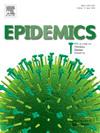Transmission dynamics of Norovirus GII and Enterovirus in Switzerland during the COVID-19 pandemic (2021–2022) as evidenced in wastewater
IF 2.4
3区 医学
Q2 INFECTIOUS DISEASES
引用次数: 0
Abstract
Noroviruses and enteroviruses are major causes of endemic gastrointestinal disease associated with substantial disease burden. However, viral gastroenteritis is often diagnosed based on symptoms, with etiology infrequently tested or reported, so little information exists on community-level transmission dynamics. In this study, we demonstrate that norovirus (NoV) genogroup II and enterovirus (EV) viral loads in wastewater reveal transmission dynamics of these viruses. We report NoV and EV concentrations in wastewater from 363 samples between December 5 2020 and October 10 2022 (sampled every second day). Virus concentrations in wastewater were low during 2021, and increased in 2022. Wastewater recapitulated periods of increased clinical cases, and also identified silent waves of transmission. We used the measured wastewater loads to estimate the effective reproductive number (Re). The Re for both NoV and EV peaked between 1.1 and 1.2. However, the usual seasonality of NoV transmission was upended by non-pharmaceutical interventions implemented to mitigate the COVID-19 pandemic, leading to correlated transmission dynamics of NoV GII and EV during 2021–2022. This highlights the use of wastewater to understand transmission dynamics of endemic enteric viruses and estimate relevant epidemiological parameters, including Re.
2019冠状病毒病大流行期间(2021-2022年)诺如病毒GII和肠病毒在瑞士的传播动态——废水中的证据
诺如病毒和肠病毒是地方性胃肠道疾病的主要病因,与重大疾病负担相关。然而,病毒性肠胃炎通常是根据症状诊断的,很少检测或报告病因,因此关于社区层面传播动态的信息很少。在这项研究中,我们证明了诺如病毒(NoV)基因组II和肠病毒(EV)在废水中的病毒载量揭示了这些病毒的传播动力学。我们报告了2020年12月5日至2022年10月10日(每隔一天采样一次)期间363个样本的废水中NoV和EV浓度。2021年废水中的病毒浓度较低,2022年有所上升。废水重现了临床病例增加的时期,并确定了无声传播波。我们使用测量的废水负荷来估计有效繁殖数(Re)。NoV和EV的Re均在1.1 - 1.2之间达到峰值。然而,为缓解COVID-19大流行而实施的非药物干预措施颠覆了NoV传播的通常季节性,导致2021-2022年期间NoV GII和EV的相关传播动态。这强调了利用废水来了解地方性肠道病毒的传播动力学和估计相关的流行病学参数,包括Re。
本文章由计算机程序翻译,如有差异,请以英文原文为准。
求助全文
约1分钟内获得全文
求助全文
来源期刊

Epidemics
INFECTIOUS DISEASES-
CiteScore
6.00
自引率
7.90%
发文量
92
审稿时长
140 days
期刊介绍:
Epidemics publishes papers on infectious disease dynamics in the broadest sense. Its scope covers both within-host dynamics of infectious agents and dynamics at the population level, particularly the interaction between the two. Areas of emphasis include: spread, transmission, persistence, implications and population dynamics of infectious diseases; population and public health as well as policy aspects of control and prevention; dynamics at the individual level; interaction with the environment, ecology and evolution of infectious diseases, as well as population genetics of infectious agents.
 求助内容:
求助内容: 应助结果提醒方式:
应助结果提醒方式:


